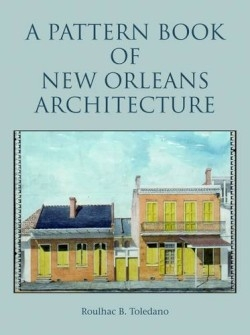A Pattern Book of New Orleans Architecture
Nearly five years ago, Hurricane Katrina swept through New Orleans, subjecting one of North America’s most beloved cities to tremendous water damage. The architecture of New Orleans is a unique reflection of the city’s rich and colorful history, and so as the city continues to rebuild, architects, planners, and building professionals endeavor to preserve the city’s architectural heritage. With this book, homeowners and professionals alike can pore over 100 of the nearly 5,000 watercolor and gouache renderings of New Orleans architecture currently preserved at the New Orleans Notarial Archives.
Author, lecturer, authority on historical architecture, and winner of the 1997 American Institute of Architects International Book Award, Roulhac B. Toledano has gathered 121 historical color illustrations dating from 1803 to 1918, and combined those images with thirty color and thirty-five black and white photos to capture what “old, renovated, restored, and new buildings might look like and should look like…[the] paintings and drawings serve as a pattern book of New Orleans architecture.” In addition to the many elevations and neighborhood plot plans, twenty-five black and white illustrations provide floor plans of many traditional homes, including Creole townhouses, shotguns, camelbacks, and villas.
Toledano’s history of New Orleans’ architecture is broken into four sections. Though the first two sections, “Who and What Created New Orleans?” and “Recorders of New Orleans Building History,” read like a genealogy report, they comprise only ten percent of the book, and those who wish to trace the history of New Orleans’ surveyors or the method by which the architectural documents were commissioned or gathered may find this interesting. The bulk of the book is pictorial, divided between two additional sections, “Pattern Book for New Orleans Architecture” and “New Orleans Neighborhoods from Archival Drawings,” each of which is subdivided into chapters, according to the nationality of the architects or surveyors. The textual history in these sections is more lively than the earlier two sections, but it is the diversity of the visual representation that really serves the author’s intent. The nineteenth-century color gouache and watercolor drawings and paintings are beautifully represented, and it is through these renderings that the charm and diversity of New Orleans architecture is conveyed.
Recommended for building professionals as well as city planners, architecture enthusiasts, and anyone longing to walk the streets of nineteenth-century New Orleans.
Disclosure: This article is not an endorsement, but a review. The publisher of this book provided free copies of the book to have their book reviewed by a professional reviewer. No fee was paid by the publisher for this review. Foreword Reviews only recommends books that we love. Foreword Magazine, Inc. is disclosing this in accordance with the Federal Trade Commission’s 16 CFR, Part 255.

